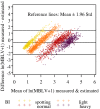Estimation of menstrual blood loss volume based on menstrual diary and laboratory data
- PMID: 22906181
- PMCID: PMC3554478
- DOI: 10.1186/1472-6874-12-24
Estimation of menstrual blood loss volume based on menstrual diary and laboratory data
Abstract
Background: Abnormal uterine bleeding is often investigated in clinical studies and critical to identify during gynecological consultation. The current standard for quantification of menstrual blood loss is the alkaline-hematin-method. However, this method is expensive and inconvenient for patients. Bleeding diaries, although widely used, provide only qualitative information on menstrual blood loss. Other methods have been developed, but still do not provide reliable quantitative data.
Methods: We estimated blood loss volume using data from two clinical studies in women suffering abnormal menstrual bleeding. These estimations were derived from mixed linear models based on diary data, hematological parameters and age. To validate the models, we applied our results to data from a third study with a similar patient population.
Results: The resulting best fitting model uses diary entries on bleeding intensity at a particular day, information on occurrence and frequency of single bleeding intensities in defined time windows, hemoglobin and ferritin values and age of the patient all as predictors of menstrual blood loss volume. Sensitivity and specificity for the diagnosis of excessive bleeding were 87% and 70%, respectively. Our model-based estimates reflect the subjective assessment by physicians and patients in the same way as the measured values do.When applying the model to an independent study, we found a correlation of 0.73 between estimated and measured values for the blood loss in a single day. Further models with reduced number of parameters (simplified for easier practical use) still showed correlation values between 0.69 and 0.73.
Conclusions: We present a method for estimating menstrual blood loss volume in women suffering from prolonged or excessive menstrual bleeding. Our statistical model includes entries from bleeding diaries, laboratory parameters and age and produces results which correlate well with data derived by the alkaline-hematin-method. Therefore, this model may be used to estimate menstrual blood loss volume in both routine gynecological counseling and clinical studies.
Figures
Similar articles
-
A systematic review of methods to measure menstrual blood loss.BMC Womens Health. 2018 Aug 22;18(1):142. doi: 10.1186/s12905-018-0627-8. BMC Womens Health. 2018. PMID: 30134884 Free PMC article.
-
A simple and feasible questionnaire to estimate menstrual blood loss: relationship with hematological and gynecological parameters in young women.BMC Womens Health. 2014 May 30;14:71. doi: 10.1186/1472-6874-14-71. BMC Womens Health. 2014. PMID: 24886470 Free PMC article.
-
Outcome measures for heavy menstrual bleeding.Womens Health (Lond). 2016 Jan;12(1):21-6. doi: 10.2217/whe.15.85. Epub 2015 Dec 23. Womens Health (Lond). 2016. PMID: 26693585 Free PMC article. Review.
-
Estimating menstrual blood loss in women with normal and excessive menstrual fluid volume.Obstet Gynecol. 2001 Nov;98(5 Pt 1):806-14. doi: 10.1016/s0029-7844(01)01581-2. Obstet Gynecol. 2001. PMID: 11704173
-
Determination of total menstrual blood loss.Fertil Steril. 2001 Jul;76(1):125-31. doi: 10.1016/s0015-0282(01)01847-7. Fertil Steril. 2001. PMID: 11438330
Cited by
-
A systematic review of methods to measure menstrual blood loss.BMC Womens Health. 2018 Aug 22;18(1):142. doi: 10.1186/s12905-018-0627-8. BMC Womens Health. 2018. PMID: 30134884 Free PMC article.
-
Efficacy of recombinant bovine basic fibroblast growth factor to reduce hemorrhage after cervical loop electrosurgical excision procedure.BMC Womens Health. 2023 Jul 21;23(1):385. doi: 10.1186/s12905-023-02474-1. BMC Womens Health. 2023. PMID: 37479994 Free PMC article.
-
A simple and feasible questionnaire to estimate menstrual blood loss: relationship with hematological and gynecological parameters in young women.BMC Womens Health. 2014 May 30;14:71. doi: 10.1186/1472-6874-14-71. BMC Womens Health. 2014. PMID: 24886470 Free PMC article.
-
Validation of a menstrual pictogram and a daily bleeding diary for assessment of uterine fibroid treatment efficacy in clinical studies.J Patient Rep Outcomes. 2020 Nov 13;4(1):97. doi: 10.1186/s41687-020-00263-0. J Patient Rep Outcomes. 2020. PMID: 33185783 Free PMC article.
-
Determinants and Assessment of Menstrual Blood Flow.Curr Epidemiol Rep. 2023 Dec;10(4):210-220. doi: 10.1007/s40471-023-00332-0. Epub 2023 Sep 21. Curr Epidemiol Rep. 2023. PMID: 38275001 Free PMC article.
References
MeSH terms
LinkOut - more resources
Full Text Sources
Medical


